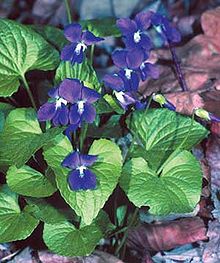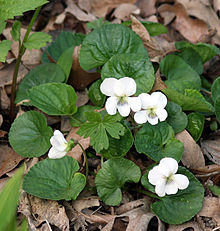- Viola sororia
-
Viola sororia 
Scientific classification Kingdom: Plantae Phylum: Spermatophytes (unranked): Eudicots (unranked): Rosids Order: Malpighiales Family: Violaceae Genus: Viola Species: V. sororia Binomial name Viola sororia
Willd.Synonyms Viola papilionacea
Viola sororia, known commonly as the Common Blue Violet, is a stemless herbaceous perennial plant that is native to eastern North America. It is known by a number of common names including; Common Meadow Violet, Purple Violet, Woolly Blue Violet, Hooded Violet and Wood Violet.
It is the state flower of Wisconsin, Illinois, Rhode Island, and New Jersey.
Self-seeding freely, in lawns and gardens it can become a weed. Cleistogamous seed heads may also appear on short stems late summer, early autumn.
Uses
Beyond its use as a common lawn and garden plant, Viola sororia has historically been used for food and for medicine. The flowers and leaves are edible, and some sources suggest the roots can also be eaten. The Cherokee used it to treat colds and headaches. Rafinesque, in his Medical Flora, a Manual of the Medical Botany of the United States of North America (1828–1830), wrote of Viola sororia being used by his American contemporaries for coughs, sore throats, and constipation.
References
- Viola sororia from the Connecticut Botanical Society
- Viola sororia from the Virginia Tech Weed Identification Guide
- 2003-04 Wisconsin Statutes & Annotations: 1.10 State song, state ballad, state waltz, state dance, and state symbols.
- USDA Plants Profile
- Duke, James. 1992. Handbook of Edible Weeds. CRC Press, Boca Raton, FL.
- Viola sororia: University of Wisconsin-La Crosse
This Violaceae article is a stub. You can help Wikipedia by expanding it.

